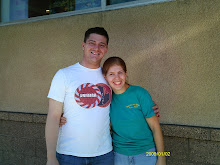For health insurance purposes, the government of Korea requires foreigners to pass a medical inspection of sorts, which basically consists of minor x-rays, vision screening, and a drug test. It is also needed in order to obtain a residency permit. Just days after my arrival, Lauren took me to the hospital to get this check-up. Though she noted that the hospital we visited was the exception in Korea rather than the rule, I found the differences between a visit like that in the States and here to be vast.
While hospitals in the States tend to look clean, crisp, and bright, the one I visited in Chungju was very dim and dusty. American hospitals are usually supplied with bright, florescent bulbs spaced profusely throughout the ceilings to insure adequate lighting; here, no such accomodations were present. Lighting was intermitten, at best. Even the colors used to decorate showed the difference between the two places: Hospitals in the States tend to be white with blue or a muted maroon, but this one was brown, yellowish, and an off-white, almost gray. The colors could habe been due to the lighting, yes. The floor itself was unique: If memory serves, there was a pervasive red line to one side of the hall that, presumably, led to different offices or corridors. Also, I noticed a dingy, bumpy yellow strip down the center of the aisle (present also along sidewalks outside), which, I learned, was an aid to guide the blind.
The hospital itself gave the impression of going to a doctor's office, rather than a clinic or full hospital. There seemed to be no hierachy of space, no separation between the lobby and the sanitary hospital halls. The nurses' desk, which looked like the receptionist's station, was mostly wooden, adding to that same feel. Little offices seemed to be around every corner. When I went to have my eyes checked, I followed Lauren into a room that could have been a filing room, as full as it looked with papers and well-dressed office staff. I read a standard eyesight chart on a wall that looked like it was from another era. The room reminded me of what a 1950s library or secretary's office might have looked like. This contrasted with the weight machine that the staff had me step onto: it was completely digital. Whereas I am used to manual scales that balance with actual weights and a manual ruler, this device took my weight digitally and automatically brought down a stick to measure my height. I was so impressed!
Bodily fluids seemed to be handled more carelessly than in the States. For example, in the US nurses who take your blood usually wear special gloves, put you in a separate room, and quarantine any equipment which comes in contact with blood. Here, my blood was taken in a small room that looked like another office. I was asked to put my arm up on what looked like a secretary's desk! Lauren assured me that the needle was sanitary and that the procedure itself was safe. Though I have no doubts about that, I couldn't get over how vastly different the same procedure would have been in the US. Urine taken for drug tests also seems to be handled differently. In the States, the attending nurse usually gives you a sealed plastic jar with your name on it. I remember needing to sign affidavits the last time I had a drug test done. But here, all they give you (or at least all they gave me) is small Dixie cup, no name, no affidavit, nothing to prevent me from contaminating the sample.
Though I have to keep in mind Lauren's comment that this hospital was different than most in the country, I still find the contrast between the procedural habbits of medical staff in both countries to be immense. This may not be how it is everywhere in Korea, but I certainly find it shocking to note that it is still present somewhere.
Subscribe to:
Post Comments (Atom)

No comments:
Post a Comment